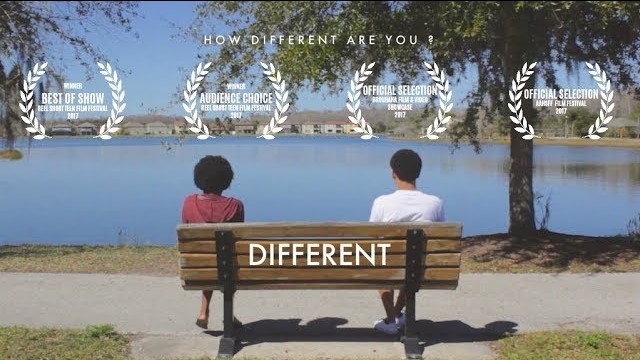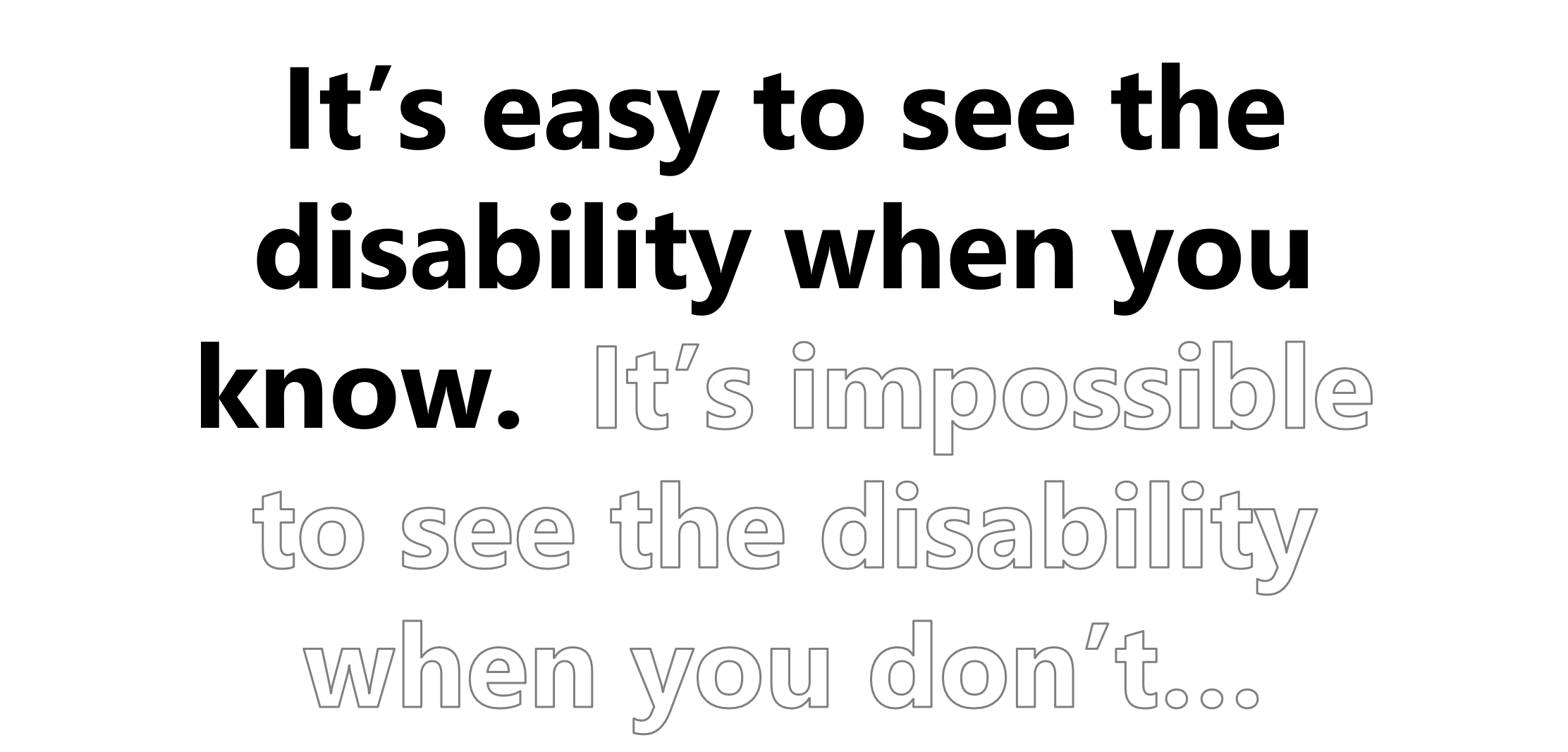
What conclusions do you draw from this video?
Did you spot any visible disabilities?
Do you think either of them has a disability?
If you were not watching a video on ‘disabilities’, would you give the issue of disability a second thought?

& did you think…
Why doesn’t he get up to help her?
Why isn’t she answering him?
» now watch the rest »

audio
Some disabilities are obvious – because they affect two of our main senses:
we can see them
we can hear them
And so we can adjust and take them, and the individual into account.
But what about invisible, or unseen, disabilities?
“Globally 1 in 7 of us live with a disability. And of those, 80% are invisible. That is 1 billion people who are living with a non-visible disability.” (hiddendisabilitiesstore.com)
There are a number of problems to address:
they are not visible
the individual may not want them to be recognized
you may not even know of them (as a disability)
you may know, but not accept, them a disability
Some examples of invisible disabilities include autism spectrum disorder, depression, diabetes, and learning and thinking differences such as ADHD and dyslexia. Invisible disabilities can also include symptoms such as chronic pain, fatigue, and dizziness.
Common features of unseen disabilities:
Others cannot ‘see’ the disability
There are no visible supports
They have to cope daily with the disability AND that it is unseen
Often the management of the disability is unseen (eg privately taken medication)
It has to be approved for special treatments to be made available
There is still some prejudice against certain types of unseen disability – ie some challenge it as unreal or seeking undeserved ‘special favours’
AND:
The individual may not
know they have this condition
know, but do not know it is a disability and/or treatable
be able to articulate their condition
feel comfortable ‘claiming’ their rights
feel validated in their condition by others
wish to declare an unseen disability for fear of prejudiced or discrimination
Visible & Invisible
Some disabilities are obvious, because...
… they affect two of our main senses:
- We can see them
- We can hear them
.
And so we can adjust and take them, and the individual into account.
But what about invisible, or unseen, disabilities?
“Globally 1 in 7 of us live with a disability. And of those, 80% are invisible. That is 1 billion people who are living with a non-visible disability.”
(hiddendisabilitiesstore.com)

There are a number of problems to address…
- They are not visible
- The individual may not want them to be recognized
- You may not even know of them (as a disability)
- You may know, but not accept, them a disability
Some examples of invisible disabilities include:
Autism spectrum disorder, depression, diabetes
Learning and thinking differences such as ADHD and dyslexia.
Symptoms such as chronic pain, fatigue, and dizziness.

Common features of unseen disabilities:
- Others cannot ‘see’ the disability
- There are no visible supports
- They have to cope daily with the disability AND that it is unseen
- Often the management of the disability is unseen (eg privately taken medication)
- It has to be approved for special treatments to be made available
- There is still some prejudice against certain types of unseen disability – ie some challenge it as unreal or seeking undeserved ‘special favours’
& the individual may not…
- Know they have this condition
- Know, but do not know it is a disability and/or treatable
- Be able to articulate their condition
- Feel comfortable ‘claiming’ their rights
- Feel validated in their condition by others
- Wish to declare an unseen disability for fear of prejudiced or discrimination
So remember...


organisations
Here are our top ten suggestions for how organisations can demonstrate their commitment to supporting those with disability in the workplace:
- treat everyone as equal: hey have the same rights and responsibilities
- provide equity in the workplace (eg by making the workplace more accessible); equity may be more important than equality; equity means treating each person according to their need, and those with disabilities may have needs which require and justify special and different treatment to allow them to be at and give their best
- with anyone with a disability, start from an assumption of ‘they can’, not ‘they can’t’; the very word ‘disability’ creates the sense of ‘a lack of ability’, which is unfair. Focus on what they can do, and assume the best
- ask those with disability what would work best for them, then deliver it; don’t assume – don’t guess. The best person to ask what they want or need is them – and what they need or want may not be what you think they need or want
- work out what’s the very best you can do, then do it: if they want a helping hand, then give it; if they want to do things for themselves, let them do it
- find out what is best practice elsewhere, then match it; there is no need to guess or reinvent the wheel. There is best practice out there – be bothered to find it
- help others to help others: encourage support and affirmative action; spread the word, spread the investment; create a ripple effect, so that exceptional treatment is common practice
- run appropriate training and coaching programmes; make them mandatory, and more than just raising awareness and increasing knowledge. Provide skills development that may be valuable
- make the workplace fit the worker, not vice versa. Make every effort to adapt and modify the working environment, rather than expect the individual to adapt and modify themselves
- have a budget for affirmative action; a budget is a visible and important sign of commitment; so is spending it in ways that show and add value
- Audio Transcript
- And here are our top ten suggestions for what you, as an individual, can do:
- treat everyone as equal: because in all other respects, they are
- avoid attribution bias – ie because they have this disability, they won’t want to go clubbing/babysit/give me a lift/eat lunch with me outside
- don’t assume: ask before helping, or if you’re not sure what to do
- don’t assume they do or don’t have a disability: remember, most disabilities are unseen and invisible
- don’t stare: this can be hard, as a evolutionary reflex. But equally, don’t look away. Just…engage…human to human…
- speak directly to them: avoid “does he take sugar?”. Don’t patronise.
- avoid labelling or emphasising any disability; focus on the person, not the disability
- be comfortable with and around disability; that’s often the best gift you can give
- be a role model and the best you can be – always, not occasionally
- work with and value the person: they will work with their disability
individuals
And here are our top ten suggestions for what you, as an individual, can do:
- treat everyone as equal: because in all other respects, they are
- avoid attribution bias – ie because they have this disability, they won’t want to go clubbing/babysit/give me a lift/eat lunch with me outside
- don’t assume: ask before helping, or if you’re not sure what to do
- don’t assume they do or don’t have a disability: remember, most disabilities are unseen and invisible
- don’t stare: this can be hard, as a evolutionary reflex. But equally, don’t look away. Just…engage…human to human…
- speak directly to them: avoid “does he take sugar?”. Don’t patronise.
- avoid labelling or emphasising any disability; focus on the person, not the disability
- be comfortable with and around disability; that’s often the best gift you can give
- be a role model and the best you can be – always, not occasionally
- work with and value the person: they will work with their disability
What can we do?
If you'd like some more detailed guidance on specific disabilities, this is a great resource:
Here, in summary form, are our top ten tips that organisations and individuals can do to work well with anyone who has a disability.
- Treat everyone as equal
- Provide equity in the workplace (eg by making the workplace more accessible)
- With anyone with a disability, start from an assumption of ‘they can’, not ‘they can’t’
- Ask those with disability what would work best for them, then deliver it
- Work out what’s the very best you can do, then do it
- Find out what is best practice elsewhere, then match it
- Help others to help others: encourage support and affirmative action
- Run appropriate training and coaching programmes
- Make the workplace fit the worker, not vice versa
- Have a budget for affirmative action
- Treat everyone as equal
- Avoid attribution bias – ie because they have this disability, they…
- Don’t assume: ask before helping or if you’re not sure what to do
- Don’t assume they do or don’t have a disability
- Don’t stare
- Speak directly to them: avoid “does he take sugar?”
- Avoid labelling or emphasising any disability
- Be comfortable with and around disability
- Be a role model and the best you can be – always, not occasionally
- Work with and value the person: they will work with their disability
want more?...
The Myth of Average
Engaging and convincing presentation on how planning for average can be totally mistaken - and costly.watch on youtube.com








